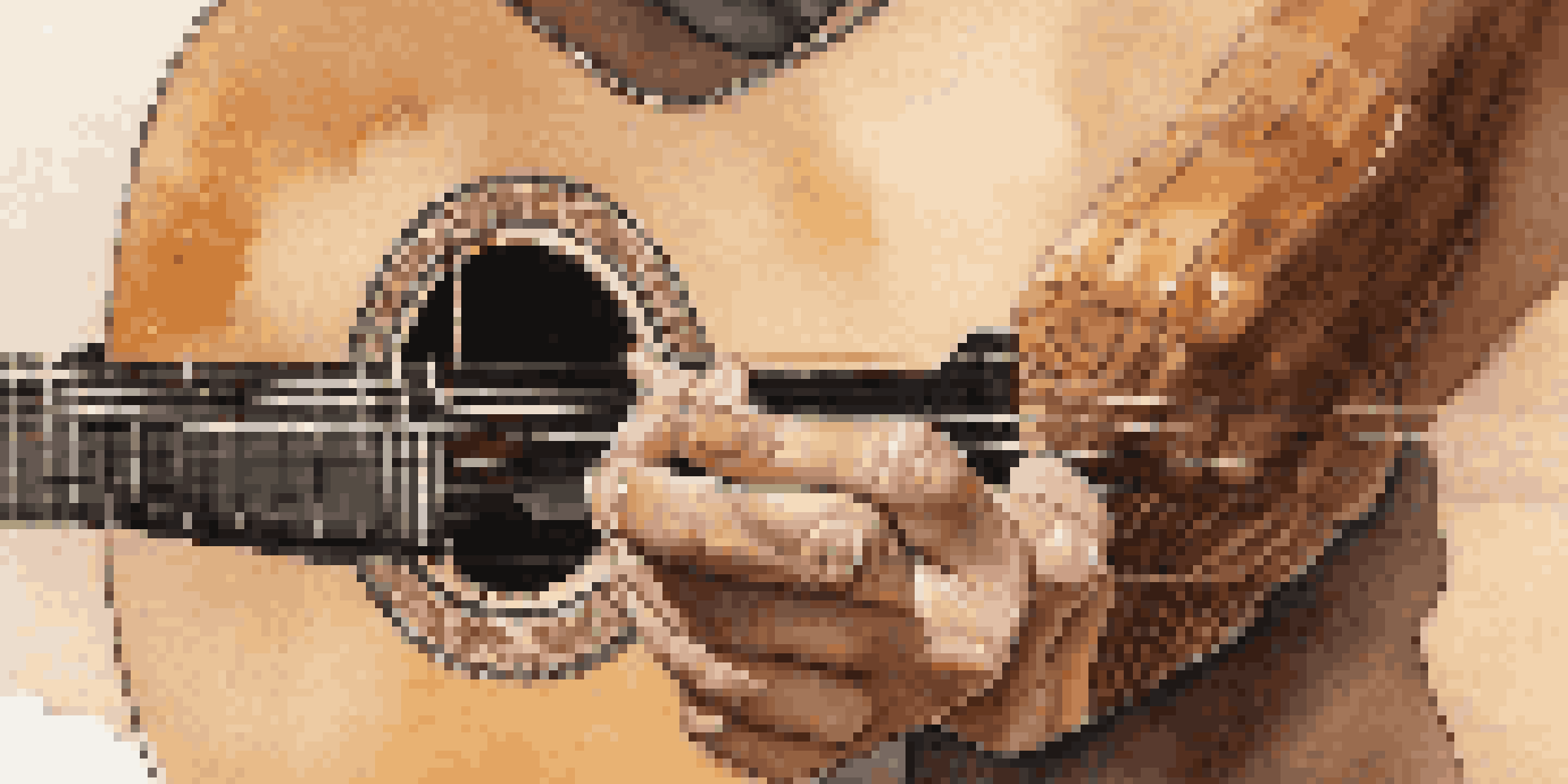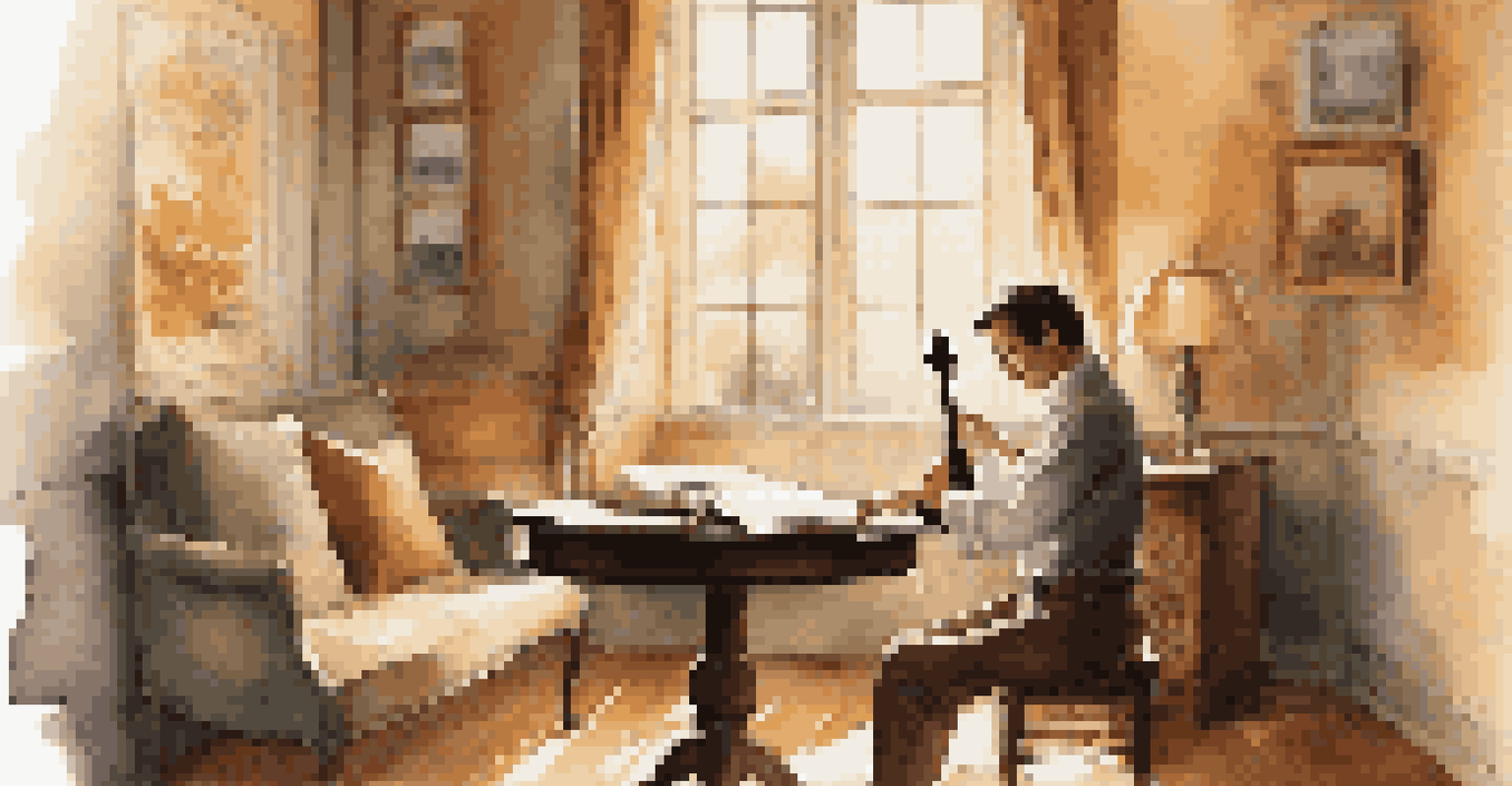Exploring Unique Finger Techniques for Classical Guitar

Understanding the Basics of Finger Techniques
Before diving into unique finger techniques, it's essential to grasp the basics. Classical guitar relies heavily on finger positioning and movement, which forms the foundation for more complex techniques. By mastering your finger placement, you set yourself up for success as you explore innovative methods to enhance your playing.
The guitar is a miniature orchestra in itself.
Think of your fingers as musicians in their own right. Each finger has a specific role, similar to how different instruments contribute to an orchestra. Understanding this hierarchy helps you appreciate the importance of each finger in producing beautiful melodies and harmonies on the guitar.
Once you're comfortable with the basics, you'll find it easier to experiment with new techniques. This exploration not only makes practice more enjoyable but also opens up a world of creative possibilities in your music.
The Importance of Finger Independence
Finger independence is crucial for any classical guitarist aiming to play complex pieces. This technique allows each finger to move freely and efficiently, enabling you to play intricate patterns without getting tangled up. It’s like training for a sport—strengthening your fingers helps you perform at a higher level.

To develop finger independence, practice exercises that focus on each finger's movement separately. For instance, try playing scales or simple melodies using one finger at a time. This method not only improves dexterity but also builds muscle memory, making it easier to incorporate into your playing.
Mastering Finger Techniques
Understanding and practicing basic finger techniques lays the foundation for advanced classical guitar skills.
As you progress, challenge yourself with exercises that require multiple fingers to work together. This balance will help you achieve the fluidity needed for advanced classical guitar techniques.
Exploring the Rest Stroke Technique
The rest stroke, or 'apoyando', is a fundamental technique in classical guitar that produces a rich, full sound. This technique involves striking the string and allowing your finger to come to rest on the adjacent string, creating a strong attack. Think of it as planting your feet firmly on the ground before making a leap—it provides stability and power.
Music is the shorthand of emotion.
To practice the rest stroke, start with a slow tempo. Focus on your finger's motion and ensure it follows through to the next string. This attention to detail not only improves your sound quality but also enhances your overall control.
Once you feel comfortable, try incorporating the rest stroke into your favorite pieces. You'll notice a significant difference in tone and dynamics, elevating your performance to new heights.
The Beauty of the Free Stroke Technique
In contrast to the rest stroke, the free stroke, or 'tirando', allows your finger to remain free after striking the string. This technique produces a lighter, more delicate sound, perfect for intricate passages and soft melodies. Imagine a feather gliding through the air—effortless yet graceful.
To master the free stroke, start by practicing with scales or arpeggios, focusing on letting your fingers float above the strings. This will help you develop a sense of fluidity and control, which is essential for executing complex pieces.
Enhancing Expressiveness
Combining various techniques like fingerpicking, hammer-ons, and harmonics allows for richer, more expressive performances.
As you gain confidence, experiment with dynamics in your playing. The free stroke lends itself beautifully to expressive performances, allowing you to convey emotions through your music.
Integrating Fingerpicking Patterns
Fingerpicking is a versatile technique that can add depth and texture to your classical guitar playing. By using different fingerpicking patterns, you can create unique rhythms and melodies, transforming simple chords into intricate compositions. Think of it as weaving a tapestry—each thread represents a different sound, coming together to form a beautiful piece.
To get started with fingerpicking, choose a simple chord progression and experiment with various patterns. Start slow, focusing on clarity and timing. As you become more comfortable, challenge yourself with more complex patterns that incorporate finger independence.
Don't be afraid to get creative! Mix and match patterns to develop your own style, ensuring that your playing remains fresh and engaging.
Utilizing Hammer-Ons and Pull-Offs
Hammer-ons and pull-offs are essential techniques that add flair to your classical guitar playing. These techniques allow you to create smooth transitions between notes without re-picking the string, producing a more fluid sound. It's like gliding across a dance floor—each movement flows seamlessly into the next.
To practice these techniques, start with simple exercises that focus on one note at a time. For hammer-ons, play a note and then 'hammer' down on a higher note with a finger of your choosing. For pull-offs, play a note and then 'pull' your finger off to reveal a lower note. This will help you develop control and precision.
Developing Finger Independence
Cultivating finger independence is essential for executing intricate patterns and achieving fluidity in classical guitar playing.
Incorporate hammer-ons and pull-offs into your favorite pieces to add a touch of expressiveness. You'll find that these techniques can significantly enhance your musical storytelling.
Exploring Harmonics for Unique Sounds
Harmonics are an exciting way to introduce new textures and colors to your classical guitar repertoire. By lightly touching the string at specific points while plucking, you can produce ethereal, bell-like tones that captivate listeners. It's akin to discovering a hidden room in a familiar house—a delightful surprise that adds depth to your music.
To practice harmonics, begin by identifying the nodes on the string where you can create these sounds, usually at the 5th, 7th, and 12th frets. Gently touch the string with your finger and pluck it with your other hand to produce the harmonic note. This requires a light touch, so adjust your technique as needed.

As you become more comfortable with harmonics, try incorporating them into your compositions. The unique sound will elevate your performance and showcase your creativity.
Combining Techniques for Expressive Playing
The beauty of classical guitar lies in its versatility. By combining various finger techniques, you can create a rich and expressive sound that tells a story. Think of it as painting a canvas—each technique adds a layer of color and texture, resulting in a masterpiece.
To achieve this, experiment with blending techniques like fingerpicking, hammer-ons, and harmonics in your practice sessions. Start with a simple melody and gradually incorporate different techniques, allowing your creativity to flow.
With practice, you'll find that these combinations enhance your expressiveness, making your performances more engaging and memorable. Embrace the journey of exploration, and enjoy the beautiful soundscapes you create along the way.